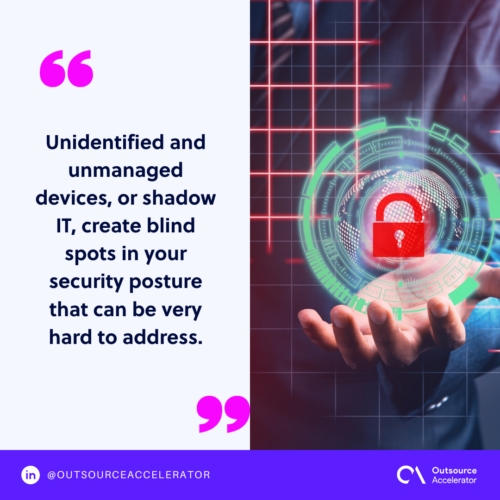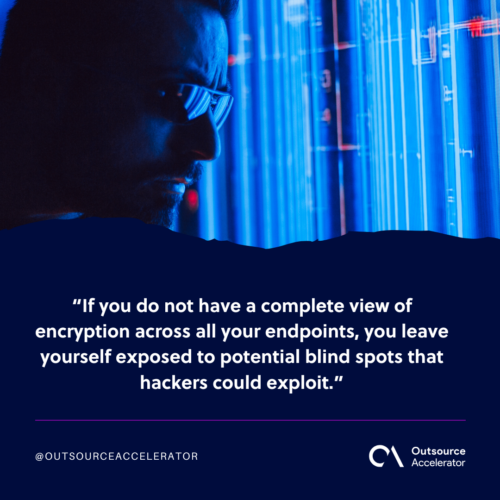4 security gaps your team can close with better endpoint management

Nobody ever plans to leave their digital front door unlocked, yet many companies unknowingly do this every day.
What many people don’t realize is that their endpoints (those laptops, smartphones, and tablets that connect to your network) essentially act as the doorways and key access points to their organization’s network and data.
Even some of the most cybersecurity-conscious companies spend time, money, and resources building sophisticated defenses while leaving critical gaps in their endpoint defense that hackers could use to bypass all the hard work they’ve been doing.
With this in mind, let’s examine some of these common issues and, more importantly, how you can fix them.
1. The “Update later” syndrome
We’ve all been there. You’re in the middle of something important, and suddenly your device nudges you with a notification to update your software at the most inconvenient time. So you click “remind me later,” and keep doing so for six months.
While snoozing on the update may buy you some time in the short term, not updating your software can be a very risky habit. Those updates often contain patches for security vulnerabilities that hackers are actively exploiting.
The Fix: If you and your team are susceptible to pushing these updates back, set up automated patch management across all endpoints.
This doesn’t mean forcing updates at inconvenient times (that likely wouldn’t go down too well with your team). Instead, schedule them during off-hours (or at least quiet times).
Make it so that specific critical security patches can’t be indefinitely postponed.
2. Unidentified device access
There’s a very good chance that your network is hosting devices you don’t even know about.
That contractor who connected their personal laptop six months ago? It’s still there.
The marketing team’s old tablet that was used for demos a couple of times? It’s still accessing sensitive files.
Unidentified and unmanaged devices, or shadow IT, create blind spots in your security posture that can be very hard to address.

The Fix: Best practice would be to implement continuous device discovery and enforce authentication for network access across all your devices. Modern endpoint security services can automatically detect when new devices connect to your network and either block them or require proper registration before granting access.
For all-around protection, look for solutions that include EPP (Endpoint Protection Platforms), which provide preventative protection, EDR (Endpoint Detection and Response), which monitors for suspicious activity, and XDR (Extended Detection and Response), which connects the dots between different suspicious events across your entire organization.
3. Excessive user privileges
When running a business, you want your people to be as productive as possible. One way of doing that is by granting everyone admin access to their machines so they won’t run into issues and need to raise IT tickets.
No more calls about installing that PDF converter or updating Chrome—sounds like a big-time save, right?
While this may provide a slight boost to productivity, giving users such unrestricted access can quickly become your business’s most significant cybersecurity vulnerability.
Admin rights let users (accidentally or intentionally) install malware, disable security controls, or change system configurations. It also means that if one system is compromised, an attacker can move around your network laterally and access whatever data they wish.
The Fix: Adopt a least-privilege approach. All users (including senior leadership) should only operate with standard accounts and permissions for the tasks they perform each day. Allow temporary privilege elevation available through a managed process only if and when needed.
While this creates bottlenecks, modern endpoint management tools can create pre-approved software catalogs where users can self-serve common applications without admin rights.
4. Inconsistent data encryption
Most companies these days have some form of encryption policy in place, especially for those operating in regulated spaces or handling sensitive customer data. But even if you already have a policy, do you know which of our devices are properly encrypted and which encryption method they use?
If you do not have a complete view of encryption across all your endpoints, you leave yourself exposed to potential blind spots that hackers could exploit.
The Fix: Centralize encryption management and monitoring. Your endpoint management solution should provide real-time visibility into encryption status across all of your devices, while automatically enforcing encryption policies.

Final word on endpoint management
Taking control of your endpoint management doesn’t always mean you’ll need to triple your security budget or hire a team of specialists around the clock. Today’s endpoint management platforms can address all four of these gaps from a single console, saving you time, money, and hassle.
If you’re looking for a place to start, look at the highest-risk areas first. These are usually patch management and device discovery.
Then, you can expand from there. Taking a phased approach means you won’t overwhelm your team, and it gives users time to adapt.
Remember that security and usability need to coexist. The most secure systems in the world fail if they’re so clumsy to use that people actively try to work around them.
Your team has enough to worry about without manually tracking every device update and permission change. Modern endpoint management automates the repetitive security tasks while giving you clear visibility into what matters.







 Independent
Independent




